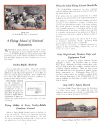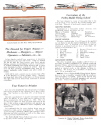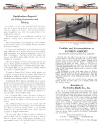Cincinnati's first airport was located in Blue Ash and was founded in 1921 as Grisard Field, named after John K. Grisard who was shot down over France in 1918. The airport was leased the following year to the brothers Hugh and Parks Watson. Hugh Watson once worked for Cecil B. DeMille in a flying circus he owned, the airport was also partially owned by Eshelby Lunken. In December of 1925 this partnership was dissolved and the Blue Ash Airport was sold to the Watson brothers. The two images above are not postcards.
LUNKEN AIRPORT
In 1921 a barnstorming pilot by the name of Dixie Davis started a flying business at the corner of Wilmer and Beechmont Ave. in an area known as Turkey Bottoms, named for the many Turkeys that roamed the area. This area is where Lunken playfield is now located. The Lunken family which included Edmund H Lunken who owned Lunken Valve became interested in the area where Davis's business was located. They purchased the 204 acres and leased it to the private Lunken Airport Company for use as an airport. In September of 1928 Lunken leased the property to the City of Cincinnati. This was a perpetual lease which assured that Cincinnati would build a Municipal Airport to be called Lunken Airport". The city bought another 870 acres from the Cincinnati Polo Club and began regular scheduled airline service in 1930. It was, at that time, the largest commercial airport in the United States, mainly due to the size of the concrete runways (most airfields in those days used grass runways). The card below (published for the Embry-Riddle Co.) shows the airfield dedication ceremonies held Sept. 26-27-28 in 1930. Howard Hughes and Jean Harlow were part of the dedication. Jimmy Doolittle, of the famous Doolittle Raid in WWII, thrilled the crowd with his stunt flying. The two covers were issued during the dedication ceremonies. The first one has been signed by one of the pilots that flew into Lunken during the dedication.
Due to its location on low lying ground surrounded by hills it was unable to expand and keep up with the rapid growth of civil aviation, which meant the new larger planes could not land there. Also as can be seen in the first row below of non-postcard images, flooding was a major concern for the airport. In 1937 the airport was referred to as "Sunken Lunken". Thus arose in Kentucky, in 1941, the beginning of The Greater Cincinnati Airport. The 2nd image below shows the control tower, constructed in 1936, almost completely under water in the 1937 flood. Today a single brick on the tower facing the airfield contains a plaque marking the high water mark of that flood (see 3rd image). The 4th image is a view from Alms Park.




1937 Flood
Lunken Tower
From Alms Park




4 Recent Non-Postcard
Images
Terminal From Airfield Side
Postcards
THE EMBRY-RIDDLE COMPANY
The Embry-Riddle Company
(Talton Higbee Embry & John Paul Riddle) organized in 1925 at Lunken and became the first government approved flight
school in the United States. They also provided air mail and airline service.
The company was financed by Embry, a wealthy aviation enthusiast. The two men
began by selling Waco Aircraft (see brochure). They started the flying school in
1926. On December 17, 1927 they established Cincinnati's first regular air mail
service, from Cincinnati to Chicago. The school grew rapidly and by 1929 they
had merged with Aviation Corporation of Delaware (AVCO). AVCO bought up other
airlines and flight schools and in 1930 they became
America Airways (the predecessor of American Airlines) which started out with
passenger flights to Chicago. There were 29,059 flights with 8,528 recorded
passengers plus 80,000 lbs of mail at Lunken in 1929. The Embry-Riddle Co. name was phased out in 1930.
By 1939 Riddle was eager to return to training pilots and so
reestablished the Embry-Riddle School of Aviation, along with the University of
Miami, to provide flight training. Riddle also formed the Riddle Aeronautical
Institute in 1941 to train pilots for the Army Air Corps. It is now known as the
Embry-Riddle Aeronautical University, located in Daytona Beach, Florida.


A rather interesting card put out by the Embry- Riddle Co.
The remaining images are not postcards
In the second image above you can see several Waco biplanes and a Stinson tri-motor. In the background you can see the original administrative offices which were replaced in 1937.

American Airlines DC-3
leaving for Chicago
EMERY-RIDDLE BROCHURE
This brochure advertises their tours of the Cincinnati area and their flights to Chicago and Indianapolis. The images above and below are in two parts due to scanner limitations. This brochure folds up to the size of the bottom right corner of the top image.
EMERY-RIDDLE BROCHURE II




![]()
Front
Page 2-3
Page 4-5
Page
6-7
Back
The brochure above is from the Embry-Riddle Company for people who wanted to learn how to fly.
One of Powel Crosley's (see WLW in Entertainment Section) many interests was in aviation. For several years the Crosley Corporation built airplanes under the auspices of the Crosley Aircraft Corporation. The 93 acre airfield was located where the Ford Motor Company's Sharonville Transmission Plant stood. Crosley built monoplanes and biplanes like the one pictured below. In addition to this venture Crosley joined with Julius Fleischmann to start the Metal Aircraft Co., in 1928, at Lunken airfield. They each put up more than $100,000 to become vice-presidents of the Company. They then started to manufacture a series of all-metal aircraft called the "Flamingo." you can see the plane above. Now that they were building the plane they needed to create a market for the Flamingo so they started an airline. They called it the Mason Dixon Air Lines in June of 1929 with daily service to Detroit. They were all set for major expansions when they suddenly sold the whole enterprise, everything, in October, 1929--just days before the stock market crash. Obviously they knew something was going to happen. Powel maintained his interest in aviation and continued building Moonbeams but, soon, that business also faded away. There is still one Flamingo flying today in South America. Through a series of mergers, the company that bought the Mason Dixon Air Lines went on to become American Airlines.


Moonbeam
biplane
Mason & Dixon Air Lines
After the stock market crash the Aeronca Aircraft Company a maker of small aircraft that started out by leasing Hangar #4 from the Metal Aircraft Co. acquired it outright. One of their early planes, a C-3 known as the Flying Bathtub, hangs from the ceiling of the terminal lobby (last 2 images below). By the mid-1930s, Aeronca lead the country in making light planes for personal use. Their success soon bred nearly two dozen competitors. The 1937 flood wiped out their plant at Lunken and they moved to Middletown where it remains today. In 1941 the company officially changed their name to Aeronca. During WWII the company produced several aircraft under license. These were liaison and observation craft, flight trainers, and gliders. They also produced parts for the B-17 Bomber and the C-46 cargo plane.


Aeronca's manufacturing
facility
The two paintings in the Lunken Terminal seen above were painted in 1937 by William Harry Gothard. The paintings were half-completed when the 1937 flood struck. The paintings were moved to the Union Terminal where they were completed. After the terminal opened they were returned to Lunken. Mr. Gothard was the Chief Conservationist of the Cincinnati Art Museum in 1937 and won a Federal Art Project competition for the paintings. The first painting represents man being up-lifted by the power of flight while the second painting represents man being held down by the yoke of gravity. (Not Postcards)
THE GREATER CINCINNATI AIRPORT
Although
I stated on the opening page of my site that any cards that are of locations
found in Northern Kentucky would not be found here, I have decided that certain
areas are too important to the Cincinnati metropolitan area to not include them.
The Cincinnati Airport is one of these areas.
Not only is the airport located in a state other than the one it
primarily serves, it is also located on land in one county that is owned by
another county. As stated above, in 1941 Cincinnati began looking for sites
other than Lunken Field for its international airport. Encouraged by Kentucky
Congressman Brent Spence the Covington-Kenton Industrial Association secured
county approval to build an airport. They received the aid of Kentucky senator
Alben Barkley and Colonel Lucius Clay of the Army Air Corps transport Corps, and
received $2 million in CAA funds. Ground was broken in 1943.
The land chosen was located 13 miles south of Cincinnati in Boone County
because it was flat and had good elevation to reduce fog. Boone County land was
also inexpensive. The head of Boone County Fiscal Court Judge N.E. Riddle, was
unwilling to assume responsibility for the project, so in 1942 the Covingtonians
sought and received approval from the Kentucky legislature to purchase land in
Boone County in behalf of Kenton County.
During WWII The Kenton County Airport was used by the military. In
October 1946 the airport was dedicated as a civilian air terminal and was named
the Greater Cincinnati Airport. The 3 airlines serving Cincinnati-American,
Delta, and Trans-World--abandoned Lunken for the new facility in Kentucky.
When commercial service began in 1947 the airport consisted of 928 acres
of land. There has been several expansions since and is now one of the major
hubs in the world.
You will see the letters CVG when ever the airport is mentioned, these
letters stand for Covington, the largest city in Kenton County.
These are not Postcards.


Airport in late 40's
Airport in 2000





Interior of original
terminal
After expansion-2000 acres


 *
* 
Two artist renderings of a 1974 expansion
Wileswood Country Stores (3 stores at CVG)
*Thanks to Scott Kabakoff
On July 19, 1912 Colonel Paul Peck landed on the racetrack, which they used as a runway, at Coney Island on one of the first flights to carry U.S. Airmail. Peck carried a sack of mail filled with postcards sold at Coney Island and stamped "U.S. Official Aerial Mail Stamp." The bag was dropped on a ball field in nearby California and was picked up by Frank Beatty, the assistant to the Cincinnati Post Office Superintendent, and California's RFD mail carrier, Arthur Ryall. It was Cincinnati's first official airmail.
FLYING MACHINE BROADSIDE
The images below are of a two-sided broadside for the Kohl & Middleton's Dime Museum that was located between 5th and 6th Streets on Vine. Middleton's operated in Cincinnati between 1886 and 1895 so obviously there are no postcards available. The broadside features the flying machine of Professor Jule Milton that was issued on July 8, 1889. I have turned the backside 90 degrees so you don't hurt yourself.
This RPPC shows Lincoln J. Beachly flying over Cincinnati in June of 1912. Beachly was a pioneer American aviator and stunt pilot. He was known as "The world's Greatest Aviator". He was called The Man Who Owns the Sky, and also as the Master Birdman. During his short career (he died in a crash in 1915) it has been estimated that 30 million people saw him perform, 17 million in 1914 alone. His funeral in San Francisco was said to be the largest in the city's history up until then. He was famous for the clothes he wore during his flights. He wore a business suit, starched collar and a diamond stick pin. His trademark was a checkered golf cap. This attire was his way of proving that aviation had arrived in the mainstream of civilization.
Another pioneer aviator was Art Smith who was as celebrated as any movie star of today. His barnstorming feats consisted of dives, "death spirals," sky writing, and, as the card above states, "loop-de-loops." He flew at night using phosphorus fireworks. Art Smith died while flying for the U.S. Air Mail Service in 1926. After his death Lindberg dipped his wings giving credit to the "Bird Boy." He is shown with his wife Aimee in the above postcard.
Max Fleischman (1877-1951) was the younger brother of Julius Fleischmann (1872-1925). They ran the Fleischmann Yeast Co. started by their father Charles Fleischmann (1834-1897). They were also owners of the Cincinnati Reds starting in1902 (along with August Hermann and George Cox). Julius was also the Mayor of Cincinnati from 1900 to 1905. As seen in the above 2 cards Max was also an avid balloonist.




Max Fleischmann
Max
Julius
Julius
Newspaper artists renditions